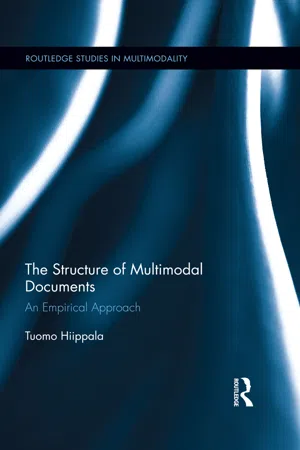
- 240 pages
- English
- ePUB (mobile friendly)
- Available on iOS & Android
About This Book
This book develops a new framework for describing the structure of multimodal documents: how language, image, layout and other modes of communication work together to convey meaning. Building on recent research in multimodal analysis, functional linguistics and information design, the book examines the textual, visual, and spatial aspects of page-based multimodal documents and employs an analytical model to describe and interpret their structure using the concepts of semiotic modes, medium and genre. To demonstrate and test this approach, the study performs a systematic, longitudinal analysis of a corpus of multimodal documents within a single genre: an extensively annotated corpus of tourist brochures produced between 1967-2008. The book provides multimodal discourse analysts with methodological tools to draw empirically-based conclusions about multimodal documents, and will be a valuable resource for researchers planning to develop and study multimodal corpora.
Frequently asked questions
Information
- New Perspectives on Narrative and Multimodality
Edited by Ruth Page
- Multimodal Studies
Exploring Issues and DomainsEdited by Kay L. O’Halloran and Bradley A. Smith
- Multimodality, Cognition, and Experimental Literature
Alison Gibbons
- Multimodality in Practice
Investigating Theory-in-practice-through-methodologyEdited by Sigrid Norris
- Multimodal Film Analysis
How Films MeanJohn A. Bateman and Karl-Heinrich Schmidt
- Multimodality and Social Semiosis
Communication, Meaning-Making, and Learning in the Work of Gunther KressEdited by Margit Böck and Norbert Pachler
- Spoken and Written Discourse in Online Interactions
A Multimodal ApproachMaria Grazia Sindoni
- Film Discourse Interpretation
Towards a New Paradigm for Multimodal Film AnalysisJanina Wildfeuer
- Critical Multimodal Studies of Popular Discourse
Edited by Emilia Djonov and Sumin Zhao
- Multimodal Approaches to Research and Pedagogy
Recognition, Resources, and AccessEdited by Arlene Archer and Denise Newfield
- Multimodal Epistemologies
Towards an Integrated FrameworkEdited by Arianna Maiorani and Christine Christie
- Multimodal Analysis in Academic Settings
From Research to TeachingEdited by Belinda Crawford Camiciottoli and Inmaculada Fortanet-Gómez
- The Structure of Multimodal Documents
An Empirical ApproachTuomo Hiippala
The Structure of Multimodal Documents

Contents
- 1 Introduction
- 1.1 Why use linguistic methods for multimodal research?
- 1.2 Why do empirical research on multimodality?
- 1.3 Why focus on multimodal structure?
- 1.4 Why study the tourist brochures?
- 1.5 Organisation of the book
- 2 Understanding page-based media
- 2.1 The state of the art
- 2.2 Turning back the page
- 2.3 Defining a mode
- 2.4 Production and consumption
- 3 An empirical approach to multimodality
- 3.1 The Genre and Multimodality (GeM) model
- 3.2 The analytical layers of the GeM model
- 3.3 The concept of a semiotic mode
- 3.4 Semiotic modes in the tourist brochures
- 3.5 Page-flow in the tourist brochures
- 4 Genre: perspectives and patterns
- 4.1 An outlook on deploying genre
- 4.2 The study of rhetoric: genre as social action
- 4.3 Linguistic studies of genre structure
- 4.4 Genre dynamics
- 4.5 Genre in document theory and information design
- 4.6 Describing the structure of a multimodal artefact
- 5 Working with multimodal corpora
- 5.1 Selecting the data
- 5.2 Applying the GeM model
- 5.3 Building the corpus
- 5.4 Verifying the corpus
- 5.5 Exploring the corpus
- 6 The medium and its characteristics
- 6.1 Why the notion of medium matte...
Table of contents
- Cover Page
- Half Title Page
- Frontmatter 1
- Title Page
- Copyright Page
- Table of Contents
- 1 Introduction
- 2 Understanding page-based media
- 3 An empirical approach to multimodality
- 4 Genre: perspectives and patterns
- 5 Working with multimodal corpora
- 6 The medium and its characteristics
- 7 The content and its structure
- 8 The page and its interpretation
- 9 Multimodal artefacts in digital media
- 10 Conclusions and outlook
- A The entire data set
- B The rhetorical relations used in GeM RST
- Bibliography
- Index